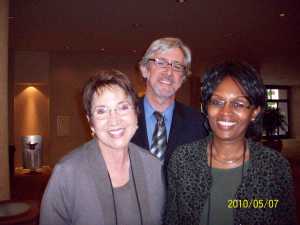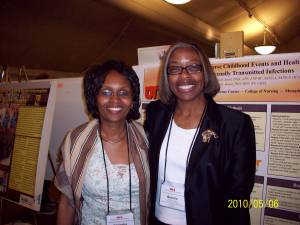Social media session at IHA Health Literacy Conference 1
My journey to IHA, California

With Gloria Mayer and Michael Villaire, authors of "Health Literacy in Primary Care: a Clinician's Guide"
About 6 months ago, Michael Villaire, Director of Programs & Operations, Institute of Health Care Advancement [IHA] asked me to facilitate a social media session at the 9th IHA Health Literacy Conference. He approached me based on Farrah Schwartz’s recommendation which was in turn based on following my blog and tweets! Now, there’s an incentive to blog and tweet!!
The “social media and health literacy” brief sounded straightforward but as I started to delve into the presentation, it dawned on me that I was not sure how best to approach this. For ideas, I contacted expert social media trainers such as AIDSgov staff [Jennie Anderson, Josie Halpern-Finnerty & Michelle Samplin-Salgado], Lee Aase of Mayo Clinic and Beth Kanter, We Are Media project. I also reached into my #hcsm network where I connected with @emacartney, @macobgyn, @pfanderson and @mindofandre among other great minds. Everyone was very helpful. I then polled my participants, posted the results and compiled a brief primer for the beginners in the group. In my preparation, I borrowed heavily from WeareMedia and AIDSgov resources and quoted liberally from Lee Aase’s social media theses. In the spirit of crowdsourcing, all I did was synthesize these great ideas, compile these resources and then facilitate a conversation.
Finally, Thursday, May 6 arrived and with it, a mixture of trepidation and excitement. There were two sessions of about 70 each, filled to maximum capacity. Technology worked smoothly with a [not so] minor exception: having to change a few minutes prior to the presentation on finding out that you cannot wear a dress and use a wireless mic because it comes with a heavy gadget that needs to be clipped to a belt!!
Approach
To my delight, social media proved to be a topic that engaged everyone a great deal regardless of their knowledge base. Based on participants’ responses to my poll, I focused on a) examples of social media use in various settings and b) strategies for social media execution. I begun with Pew and Forrester data on the adoption of these platforms by different demographic & psychographic profiles. I then highlighted examples of social media use to reach both patients and health professionals.
The widespread use of cellphones and their potential for engaging low literate populations struck a chord with many participants as I discussed the intriguing Dietary Intake Monitoring Application (DIMA), a mobile, electronic food diary for low-literacy patients developed by Kay Connelly’s team [Thanks to @pfanderson for highlighting this on her blog]. Among others, I featured the Mayo clinic culture blog, AIDSgov, Erin Macartney’s Palo Alto Medical Foundation’s FaceBook/Twitter successes, Dr. Susan Giurleo’s psychotherapy practice and @MacObgyn’s fantastic patient education portal. A participant pointed out that health providers have tended to neglect the health information needs of the deaf and hard of hearing, a growing population. She pointed out the helpful http://www.deafmd.org/ resource which provides health information in American Sign Language [ASL].
I also asked the more advanced users of these technologies in the audience to share their own experiences. For example:
- Sam Petitjohn explained how Health Literacy Missouri is using FaceBook and Twitter to build a community of health literacy practitioners.
- Manisha Shah, National Patient Safety Foundation mentioned how they are using FaceBook to share patient safety information
- Helen Osborne chimed in with a great example of how she had used Twitter to elicit questions for her Health Literacy Aloud podcast interviews [and received input from quite a few people including myself].
It is noteworthy that the above examples are targeting health professionals and not consumers/patients, implying that barriers [real or perceived] are lower in using these tools to engage health professionals. Many participants were interested in strategies to communicate with patients/consumers while respecting HIPAA concerns.
Tough questions
Understandably, some participants were skeptical about whether these tools would work for their audiences:
- One said that neither she nor her audience was using these tools but she saw the potential of cellphones.
- Chellappa Kumar said that his low literate patients were not necessarily using these platforms but the tools were valuable for reaching his physician faculty with health literacy messages.
- Janet Ohene-Frempong asked whether there was data was available on the use of these tools in low-literate populations.
- My response was: “indeed, I haven’t found hard data proving that all low literate populations are active users of these platforms because different audiences are on different media as clearly evidenced by the Pew research reports. However, one thing we can be sure of is that these tools offer valuable potential such as rendering health messages into audiovisual formats that are more accessible than traditional print and very importantly, shareable.” I haven’t found much data on the outcomes but this Health literacy, ehealth and communication workshop report which addresses e-health outcomes and challenges is useful. Chapter 4 is particularly pertinent.
- Martha Torres-Montoya, State of California wanted to know whether there were any studies comparing the impact and ROI of traditional vs social media. I promised to look into this and welcome any thoughts from those health communication gurus who are using a multipronged strategy of print, broadcast and other traditional media alongside new/social media tools.
For more reflections on lessons learned and next steps, see the next post.
This entry was posted on May 15, 2010 at 12:20 pm and is filed under E-health, Health literacy, Social media. You can subscribe via RSS 2.0 feed to this post's comments. You can comment below, or link to this permanent URL from your own site.

Leave a comment